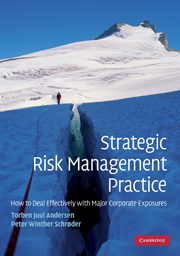Book contents
- Frontmatter
- Contents
- List of abbreviations
- List of figures
- List of tables
- List of boxes
- Preface
- 1 The strategic nature of corporate risk management
- 2 Economic exposures in corporate risk management
- 3 Managing market-related business exposures
- 4 Extending the risk management perspective
- 5 Integrative risk management perspectives
- 6 Current risk management practice and the rise of ERM
- 7 Strategic risk analyses
- 8 Strategic risk management – amendments to the ERM framework
- 9 Strategic risk management
- 10 Postscriptum
- Appendices
- Appendix 1 A strategic responsiveness model
- Appendix 2 Determining the premium on a call option
- Appendix 3 Determining the value of a real option
- Index
- References
1 - The strategic nature of corporate risk management
Published online by Cambridge University Press: 05 June 2012
- Frontmatter
- Contents
- List of abbreviations
- List of figures
- List of tables
- List of boxes
- Preface
- 1 The strategic nature of corporate risk management
- 2 Economic exposures in corporate risk management
- 3 Managing market-related business exposures
- 4 Extending the risk management perspective
- 5 Integrative risk management perspectives
- 6 Current risk management practice and the rise of ERM
- 7 Strategic risk analyses
- 8 Strategic risk management – amendments to the ERM framework
- 9 Strategic risk management
- 10 Postscriptum
- Appendices
- Appendix 1 A strategic responsiveness model
- Appendix 2 Determining the premium on a call option
- Appendix 3 Determining the value of a real option
- Index
- References
Summary
Contemporary institutions are exposed to a variety of risks ranging from natural catastrophes and uncontrolled human behaviours to different strategic exposures that may hit the organization in unexpected ways. This chapter describes, partially by illustrative examples, the diverse nature of the corporate risk landscape and how related exposures seem to increase. The chapter discusses how different approaches to risk management may enable corporate executives to deal more effectively with these important challenges. The relationship between positive risk management outcomes and performance is explored and the question about uncovering an effective risk management model is developed.
The nature of risk management
Risks are everywhere, as evidenced by many corporate events reported in the popular press, including major corporate scandals around once venerable companies like the Maxwell group, Baring Brothers, WorldCom, Enron, Parmalat and so on. We also witness a steady increase in man-made disasters around the world and even the emergence of mega-catastrophes caused by wilful human actions that have both direct and indirect economic effects. These developments have intensified our focus on corporate and public risks and the risk management processes that may be needed to circumvent the adverse economic impacts from such events. All the while, we have seen a public risk perception aimed at reducing system errors, operational malfunctions and uncontrolled human behaviours that affect the way in which we try to deal with corporate risks.
- Type
- Chapter
- Information
- Strategic Risk Management PracticeHow to Deal Effectively with Major Corporate Exposures, pp. 1 - 32Publisher: Cambridge University PressPrint publication year: 2010



